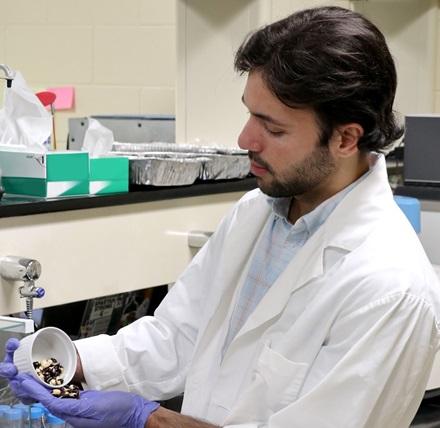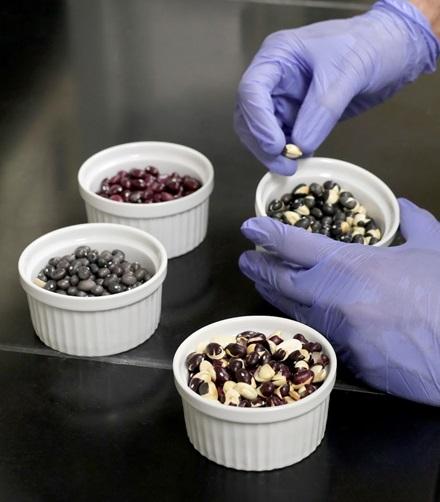These Beans Are Popping

Jose Hernandez, a student researcher, works with Popping Beans in the laboratory. This Popping Beans research, in conjunction with ARS’ Food Legume Quality Genetics Laboratory, could result in a variety of exciting food industry applications. (Photo by Somneang Oul, MSU student).
ARS researchers are looking to introduce a fiber- and protein-rich snack into the marketplace.
Beans are fiber rich and a great source of protein, but can they also be a tasty snack? Agricultural Research Service (ARS) scientists think the answer is “yes” -- and they are working to bring “Popping Beans,” a type of Ñuña bean, to market as both a grab-n-go snack and a gluten-free flour alternative for baking.
Through a partnership with Michigan State University’s College of Agriculture & Natural Resources, ARS food scientists and MSU Food Science researchers hope to increase market demand for and consumption of beans and pulses (or edible seeds), by improving their end-use and nutritional quality traits through plant breeding.
According to Karen Cichy, plant geneticist and lead researcher for the ARS Food Legume Quality Genetics Laboratory at the Sugarbeet and Bean Research Unit in East Lansing, MI, Popping Beans present many possibilities for a variety of food industry applications. Their name comes from the bean’s ability to “pop” when heated.
Traditionally, Ñuña beans are grown in the highlands of Peru. They have been a rich source of protein for people of the Andean Mountains and throughout South America for centuries. Like most beans, Ñuña, or Popping Beans, are boiled prior to consumption, but unlike other dry beans, they don’t require a long cooking time.
“We do a lot of research with regular bean flours like those made from Navy beans and kidney beans, etc., but some of those beans are difficult to work with because their nutritional and quality attributes are challenging,” explained Cichy. “Our thinking is that Popping Bean flour could address some of the issues we have with turning other dry beans into flour.”

Popping Beans and other bean varieties are considered as possible gluten-free flour substitutes for baked goods and other foods. (Photo by Somneang Oul, MSU student).
Some of those difficulties in creating a new type of Popping Bean flour, include the bean lectins (which are carbohydrate-binding proteins), and the unpleasant flavor and texture that results from processing the dry bean.
“The seed coat of a Popping Bean is different from other beans,” said Cichy. “It’s very good nutritionally, but the bean’s seed coat does not have a good texture to work with. However, the Popping Bean’s seed coat is much easier to remove than the coats of other dry beans, which has been somewhat helpful in the process.”
Through an additional ARS innovation project, Cichy has also teamed with a Michigan State University Food Science student to use specific varieties of Popping Beans to create snack products.
“He’s turning the Popping Beans into flour and he’s starting with crackers because if you could make a good cracker, then you know it’s going to be a good snack to eat,” said Cichy.
“Then our research will go further,” she added. “When we find the best bean, we can start making foods that will be appropriate for schools. For this project, we really want to focus on making breakfast foods, like pancakes or waffles. I expect by the end of next year, we should have a prototype product available.” – Tami Terella-Faram, ARS Office of Communications

